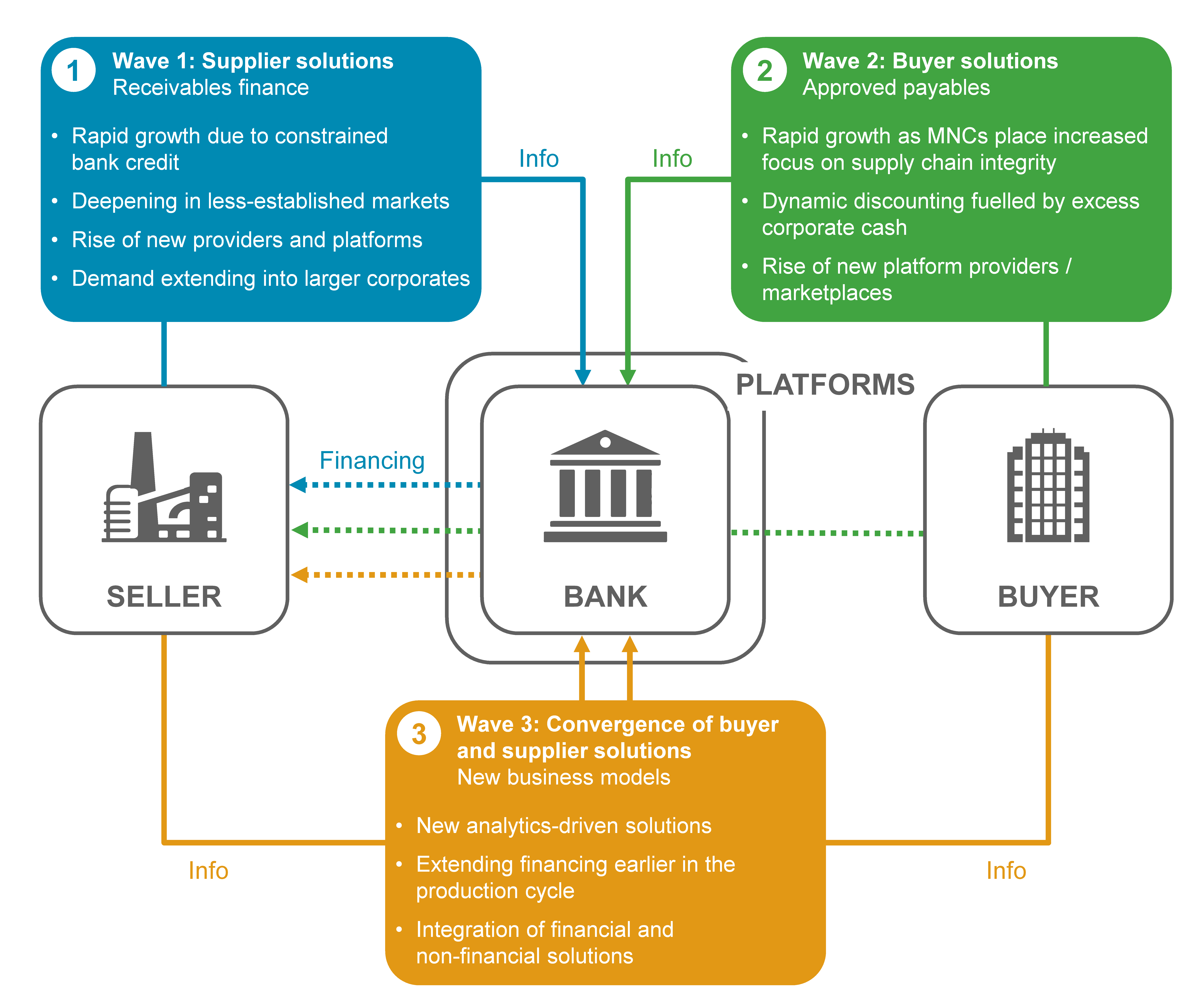What is supply chain finance?
Buyers and suppliers in a supply chain have competing financial interests. The buyer wants to pay as late as possible and the supplier wants to be paid as early as possible. Supply chain finance has emerged to bridge these conflicting interests, providing a range of financing and risk mitigation solutions designed to optimise working capital and liquidity in domestic and international supply chains. Some products are provided directly to the suppliers, others via buyers.
Three waves of growth in supply chain finance

Wave 1: Supplier solutions
Receivables finance has been around since the mid-19th century, but has seen significant growth over the last decade. In developed markets this growth has been driven by buyers extending payment terms of their suppliers (to up to 120 days in some cases), at the same time as post financial crisis restructuring has restricted unsecured credit available to smaller companies. We have also observed strong recent growth in emerging markets, where unsecured credit is often more constrained and the market for alternative financing products has been more limited.
While banks remain the largest providers of receivables finance, a number of new fintech offerings have emerged in recent years. Many of these are platform-based solutions linking borrowers and investors, such as UK-based Market Invoice and Sancus and US-based Liquid X (formerly Receivables Exchange). As these players continue to gain scale, they will put pressure on bank margins and may ultimately disintermediate banks in pockets of the market.
Wave 2: Buyer solutions
Since the emergence of buyer-led solutions over 25 years ago, this market has grown rapidly, especially over the last decade. Banks have built this business by bidding for supply chain finance programme mandates as they arise, and by pitching them to their existing large corporate clients.
Platforms have also emerged in this part of the market, with players such as PrimeRevenue, Orbian and Demica providing an aggregation service to clients, with financing available from multiple banks (and non-banks). The multi-bank nature of these providers increases competition between banks. This is not only putting pressure on margins but also driving improvements in the quality of products, with streamlined onboarding and superior interfaces that make them easier to use.
The adoption of adjacent products is also picking up pace. Dynamic discounting relies on buyers making early payments in return for a discount offered by the supplier on the goods or services purchased. Early payment can be made from the buyer’s own excess cash or from an intermediary financing provider. These products are typically supplied by technology providers such as Tungsten and Kyriba, but also by new fintechs such as Cashworks, which integrates directly with banks’ payment infrastructure.
Wave 3: Convergence of buyer and supplier solutions
Trade is becoming increasingly digital. Digital procurement tools and electronic invoice platforms are gaining scale and broadening their offering. E-commerce platforms are growing rapidly and providing integrated solutions that make buying and selling easier for companies. And rapid advances are occurring in data and analytics.
This “digital backbone” is allowing a convergence of buyer and supplier solutions, creating opportunities in what will be the third wave of growth in supply chain finance:
New, analytics-driven solutions. New and richer datasets allow supply chain finance providers to join up siloed buyer- and supplier-focused approaches and apply advanced analytics. They can use the data to identify new client opportunities by better understanding networks of buyers and suppliers; they can have richer discussions with their existing clients and identify tailored solutions; and they can price products more accurately given an improved understanding of risk in the ecosystem. These analytics rely on both “hard” data, such as purchase orders and invoice data, and “softer” information, such as buyers’ assessments of who their most strategic suppliers are.
Extending financing earlier in the production cycle. The advanced analysis of buyer and supplier data allows financing to be extended earlier in the production cycle. Today, significant volumes of “unfinanced” tradable goods sit in ships or warehouses until the invoice is approved by the buyer. New predictive analytics – based on historical purchase order, shipment, invoice and payments data – can allow financing to be extended before the invoice is approved. Banks have begun to explore the value of this data, and specialist fintechs, such as Previse and Flowcast, have launched analytics-driven business models to capture this opportunity.
Integration of financial and non-financial solutions. As outlined in our previous paper, Ecosystem thinking: why corporate banks need to adapt to survive, we see increasing convergence between financial and non-financial solutions. The digital supply chain is at the heart of this, as various players along the value chain, from sourcing through to fulfilment, seek to extend their reach and capture new revenue streams. Ariba, a provider of procurement software, has recently partnered with PrimeRevenue to offer financing solutions on an integrated platform. TradeShift, a procurement platform, has partnered with HSBC, Citi and Santander to provide integrated financing solutions via apps. And Amazon and Alibaba have launched “one stop shop” solutions for international trade, combining sourcing, shipping and financing in one seamless process.
Together, these trends point to a third wave of opportunities for the firms who can capitalise on their data advantages to develop new products and solutions. They will drive growth, as previously unmet financing needs are now met, and customer hassles are eliminated. For banks it represents both a threat and an opportunity, as non-banks – innovative fintechs, established “procure-to-pay” providers and e-commerce giants – seek to capture share.
More Information
For more information on supply chain finance – and the opportunities the three waves hold for banks – download the full version of our report.







